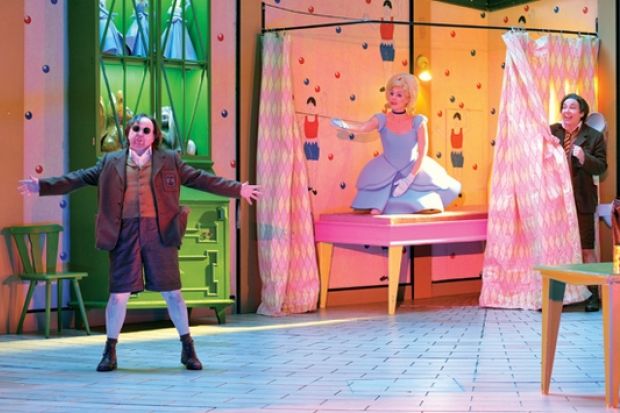The Tales of Hoffmann
In repertory at the London Coliseum, until 10 March
The strange, theatrical and often disquieting tales of E.T.A. Hoffmann (1776-1822) were a great favourite of Sigmund Freud's. Jacques Offenbach's celebrated opéra fantastique, left incomplete at his death in 1880, puts a totally fictional Hoffmann on stage, drinking himself into a stupor and recalling his three great disappointments in love.
Although it also includes some of the more uncanny elements of the original stories, notably the magic mirror the Venetian courtesan Giulietta uses to steal men's souls, the tunes are so good that it is often performed as a lavish but rather empty spectacle. In his new production for the English National Opera, director Richard Jones soon makes it clear that he has something more surreal and disturbing in mind.
Events unfold in what might be a one-room flat, set at an angle, with a basin, an alcove at the back and a dresser which later becomes a window. Hoffmann is alone, banging his head against the wall in romantic despair, until his friend Nicklausse (superbly sung by Christine Rice) emerges out of the dresser, done up as a schoolboy with cap, tie and short trousers.
They are soon joined by a crowd of drinking companions, who encourage Hoffmann to reminisce, and the setting is transformed into a girl's bedroom with jugglers on the wallpaper.
Doll maker Spalanzani and his servant, dressed like end-of-the-pier conjurors, are presenting to the world his new automaton, Olympia, who sings like an angel but keeps getting stuck on all the high notes.
The remaining acts also seem to take place in Hoffmann's half-crazed and tipsy mind. Many of the characters could be creatures of some sinister circus. The quack, Dr Miracle, is cadaverous, with damp strands of dark hair plastered over his scalp.
He manages to destroy Hoffmann's second love, the tragically consumptive singer Antonia, by suddenly appearing within the piano - shaped like a funereal obelisk - that she is playing. There is even an unexpected appearance by a man in a monkey suit.
Along with a highly competent Hoffmann (Barry Banks) and some splendidly inventive staging, this production has one huge asset: its leading lady. The Tales of Hoffmann is constructed as the story of the three contrasting women whom Hoffmann loves and loses, yet it is unusual to find a single soprano with the stamina and the dramatic range to take on all three.
Georgia Jarman triumphantly rises to the challenge. She is perfect as Olympia, whom she plays as a deranged mechanical Barbie doll. She is almost equally effective as Antonia, literally singing herself to death, and as the seductive Giulietta, flouncing around in purple, with hair to match - a rare opportunity, Jarman says, to "channel my inner Carmen".
